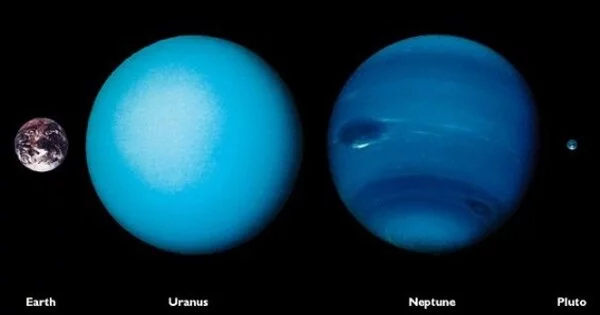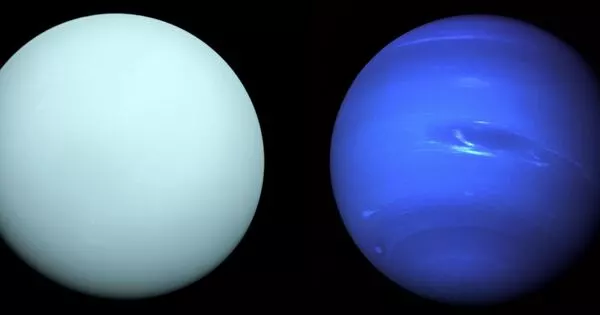Astronomers may have figured out why the planets Uranus and Neptune are different colors. Researchers built a single atmospheric model that matches observations of both planets using data from the Gemini North telescope, the NASA Infrared Telescope Facility, and the Hubble Space Telescope. According to the model, excess haze on Uranus accumulates in the planet’s stagnant, sluggish atmosphere, giving it a lighter tone than Neptune.
Neptune and Uranus have many characteristics, including similar masses, diameters, and atmospheric compositions, but their appearances are markedly different. Neptune is clearly bluer at visible wavelengths than Uranus, which is a faint shade of cyan. Astronomers now know why the two planets have different colors.
New research suggests that a layer of concentrated haze that exists on both planets is thicker on Uranus than a similar layer on Neptune and ‘whitens’ Uranus’s appearance more than Neptune’s. If there were no haze in the atmospheres of Neptune and Uranus, both would appear almost equally blue.
This result is based on a model built by an international team led by Patrick Irwin, Professor of Planetary Physics at Oxford University, to describe aerosol layers in Neptune and Uranus’ atmospheres. Previous studies of these planets’ upper atmospheres concentrated on how the atmosphere appeared at specific wavelengths. This new model, which consists of many atmospheric layers, however, matches evidence from both planets over a wide range of wavelengths. The new model contains haze particles within deeper levels that were previously considered to exclusively include clouds of methane and hydrogen sulfide ices.
This is the first model to simultaneously fit observations of reflected sunlight from ultraviolet to near-infrared wavelengths. It’s also the first to explain the difference in visible color between Uranus and Neptune.
Professor Patrick Irwin
“This is the first model to simultaneously fit observations of reflected sunlight from ultraviolet to near-infrared wavelengths,” explained Irwin, who is the lead author of a paper presenting this result in the Journal of Geophysical Research: Planets. “It’s also the first to explain the difference in visible color between Uranus and Neptune.”
The team’s model is made up of three layers of various height aerosols. The middle layer, which is a layer of haze particles (referred to in the research as the Aerosol-2 layer) that is thicker on Uranus than on Neptune, is the critical layer that impacts the colors. The team believes that methane ice condenses onto the particles in this layer on both planets, dragging the particles deeper into the atmosphere in a shower of methane snow. The team believes Neptune’s atmosphere is more efficient at churning up methane particles into the haze layer and producing this snow because it has a more active, turbulent atmosphere than Uranus. This removes more of the haze and keeps Neptune’s haze layer thinner than it is on Uranus, meaning the blue color of Neptune looks stronger.

“We thought that constructing this model will help us comprehend clouds and hazes in the atmospheres of ice giants,” said Mike Wong, an astronomer at the University of California, Berkeley and a member of the research team. “Explaining the color difference between Uranus and Neptune was a pleasant surprise!”
To create this model, Irwin’s team analyzed a set of observations of the planets encompassing ultraviolet, visible, and near-infrared wavelengths (from 0.3 to 2.5 micrometers) taken with the Near-Infrared Integral Field Spectrometer (NIFS) on the Gemini North telescope near the summit of Maunakea in Hawai’i — which is part of the international Gemini Observatory, a Program of NSF’s NOIRLab — as well as archival data from the NASA Infrared Telescope Facility, also located in Hawai’i, and the NASA/ESA Hubble Space Telescope.
The NIFS instrument on Gemini North was critical to this result because it can provide spectra (measurements of how bright an object is at different wavelengths) for every point in its field of view. This provided the team with detailed measurements of how reflective the atmospheres of both planets are across the entire disk of the planet as well as across a range of near-infrared wavelengths.
“The Gemini observatories continue to provide new insights into the nature of our planetary neighbors,” said Martin Still, National Science Foundation Gemini Program Officer. “Gemini North provided a component within a suite of ground- and space-based facilities critical to the detection and characterization of atmospheric hazes in this experiment.”
The model also helps to explain the dark spots that can be seen on Neptune but are less common on Uranus. While astronomers were aware of the presence of dark spots in both planets’ atmospheres, they didn’t know which aerosol layer was causing these dark spots or why the aerosols at those layers were less reflective. The team’s research answers these questions by demonstrating that darkening the deepest layer of their model produces dark spots similar to those seen on Neptune and possibly Uranus.















